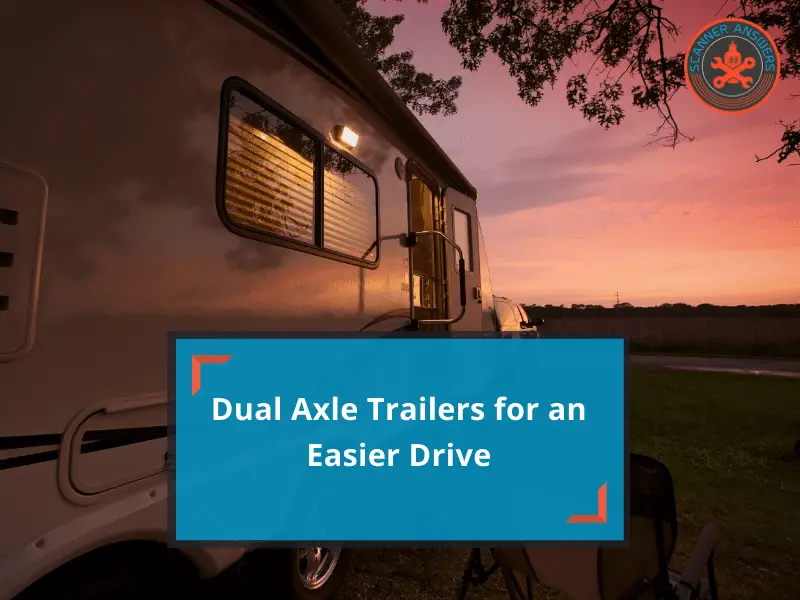
- Venture Sonic – Our Top Choice
- Airstream Globetrotter – The Luxury Option
- Genesis RV Vortex – Got Toys?
- Stealth Nomad – Simple and hauls toys (are you still a bachelor?)
When shopping for smaller travel trailers, you might expect there to be fewer decisions to make. After all, less trailer surely means fewer options, right? Not exactly. Looking for the perfect compact travel trailer requires you to make some fundamental decisions: What style of trailer fits your needs? Do you need a bathroom? How light does it need to be? One of these fundamental questions is how many axles your new camper will have. As we’ve discussed on this site before, there are advantages and disadvantages to both single and dual-axle trailers. Yet, when you take stock of the entire picture, we’re big fans of having a second axle, even on a compact camper. Let’s discuss why having a second axle can be a big advantage, and also look at some of the best small dual axle travel trailers on the market.
[su_panel background=”#ffff” shadow=”2px 2px 2px #eeeeee” radius=”4″]3 Reasons to get a dual-axle trailer
Most people automatically flock towards single axle trailers when looking for a small camper. While single axle trailers are often lighter, cheaper, and arguably cuter, they have notable drawbacks. Single axle trailers are significantly less stable when towing, more difficult to load properly, and more difficult to maneuver.
So why choose a dual-axle trailer?
[su_icon_text icon=”icon: balance-scale” icon_color=”#00a9e0″ icon_size=”33″]1. Increased Load Capacity[/su_icon_text]
Outside of the world of toy haulers, many people never give a second thought to the idea of load capacity. Despite this indifference in the eyes of many shoppers, the payload is an extremely important consideration for the safety of your trailer and your family. Many small trailers are built with budgets in mind, meaning that the frame and axle of the trailer can often be surprisingly close to their maximum weight limits before you even load a camp chair. By adding a second axle, you allow yourself to carry more water, supplies, and equipment safely with a double axle travel trailer.
[su_icon_text icon=”icon: anchor” icon_color=”#00a9e0″ icon_size=”33″]2. Easier Towing[/su_icon_text]
Beyond having a higher payload, dual-axle trailers are generally much easier to tow. Having a single axle is fine for a small utility trailer, but even the smallest campSo why choose a dual-axle trailer?er is still a fairly heavy vehicle with a large side profile. If you only have a single axle, the amount of grip resisting wind and sway forces is very small. Thus, towing single axle travel trailers in windy or high-speed conditions can quickly become a harrowing experience. This effect is compounded if you are using a relatively light-duty tow vehicle.
Stability isn’t the only consideration- a single axle trailer only has two tires. Thus, if you have a blowout, your trailer can quickly find itself with essentially zero grip, leading to loss of control or even a rollover. In contrast, a blowout in a dual-axle unit is typically a non-event with much less dramatic results.
[su_icon_text icon=”icon: car” icon_color=”#00a9e0″ icon_size=”33″]3. Easier to Maneuver[/su_icon_text]
For an owner with relatively little experience, the act of reversing a trailer can be an intimidating task. Not only are you trying to back up a much larger vehicle than you are used to, but the controls are reversed. Worse yet, you’re often under the critical gaze of the crusty full-timers who lurk in seemingly every campground. Any advantage is a welcome one. At first, the idea that a dual-axle trailer would be easier to back up seems counter-intuitive. Yet, dual axle trailers are easier to maneuver for many of the same reasons why they’re easier to tow. They have more stability, so they are less likely to jack-knife into your tow vehicle. With practice, the difference will become subtle. But for your first few outings, the dual-axle arrangement can be a welcome change.
[/su_panel] [su_panel background=”#ffff” shadow=”2px 2px 2px #eeeeee” radius=”4″]Possible drawbacks to dual-axle trailers:
As with any decision, the difference between single and double axle camper trailers is a story of pluses and minuses. While dual axle setups are typically safer and easier to handle, they also generally cost more, weigh more, and require slightly more maintenance.
If you are looking at an exceptionally small trailer or if cost is your utmost concern, then a single axle trailer may be the right choice. However, if you value durability and plan to tow your camper long distances, dual axle trailers are still the right choice.
[/su_panel] [su_panel background=”#ffff” shadow=”2px 2px 2px #eeeeee” radius=”4″]What do you need to consider when choosing a trailer?

Beyond choosing your chassi’s layout, there are a lot of factors to consider when shopping for your next camper. Small campers come in a dazzling variety of configurations, layouts, and materials. Trying to find the model that is right for you can be overwhelming. Here are some variables to consider so you can make an informed decision once you hit the dealership.
[su_icon_text icon=”icon: tags” icon_color=”#00a9e0″ icon_size=”33″]Cost vs Quality[/su_icon_text]So why choose a dual-axle trailer?
The price range of small trailers can represent a fairly extreme range. On the most budget-oriented side of things, a new compact travel trailer can be purchased for as little as $15,000. However, small doesn’t always equate to a small price tag. Higher-end models can easily cost four times this amount depending on the brand and options you choose. This is an area where the adage holds: you get what you pay for.
While many shoppers choose a compact travel trailer for budgetary reasons, the cost isn’t the only reason to shop small. Rather, many people choose small travel trailers for their simplicity, efficiency, and desire to spend time in nature.
Unfortunately, the lower end of the market can be a showcase for questionable quality. Although we would never suggest someone put themselves in financial hardship, we often suggest that shoppers buy the best trailer they can reasonably afford. Lower-end trailers are more likely to develop issues sooner in life and lead to an overall less enjoyable camping experience. A few extra dollars upfront can make a big difference a few years down the line.
[su_icon_text icon=”icon: wrench” icon_color=”#00a9e0″ icon_size=”33″]Materials and Construction[/su_icon_text]
Travel trailers are made using a huge variety of different materials and techniques. On the budget-oriented side of things, many trailers are made using thin wood studs and metal sheeting. These are often called “stick and tin” units. While this construction technique is lightweight and inexpensive, it is generally not very strong. These trailers are often less insulated and are susceptible to creaks, rattles, rotting, and delamination.
Higher-end trailers are often made using solid fiberglass construction. You can typically tell these models apart from the rest due to their distinct egg-like appearance. Different companies use this construction technique, but the process is generally the same. There is a top mold and a bottom mold, and the trailer is constructed of two solid fiberglass pieces. In essence, this is akin to placing an upside-down boat on top of another boat. Because of the lack of seams and wooden components, this technique makes for some of the strongest trailers possible. Fiberglass trailers are incredibly watertight, strong, and generally well insulated. However, this technique is expensive, and the resulting trailers tend to command a more premium price.
Finally, there are various metal-framed trailers available. These can run the gamut from simple steel frames covered in tin siding to fully aluminum models. Depending on the specific materials used, metal-framed trailers are often extremely strong while also being fairly light. Fully aluminum ones are also resistant to corrosion and rotting.
[su_icon_text icon=”icon: car” icon_color=”#00a9e0″ icon_size=”33″]How will you use your trailer?[/su_icon_text]
No trailer is perfect for every situation. A trailer that works wonderfully for you may be a terrible choice for another user. When looking for a camper, it’s important to consider how you plan to use it. If your goal is to have a weekend getaway at the local lake a few weekends every summer, you will likely be perfectly happy with a simple stick and tin single-axle camper. Yet, an increasingly large number of RVers are choosing to take their compact campers on extended trips or even live in them full time. If this is the case, you will never regret choosing a higher-quality trailer upfront.
Furthermore, the climate is a huge consideration. Do you intend to camp in extremely hot or cold conditions? If so, the relatively poor insulation of certain trailers may prove to be a detriment.
[su_icon_text icon=”icon: money” icon_color=”#00a9e0″ icon_size=”33″]Resale[/su_icon_text]
Perhaps one of the most under-considered factors when shopping for a trailer is resale value. This makes sense, as amidst the excitement of picking out your next adventure vehicle, who wants to think about selling it? However, spending some time considering resale value can make your entire ownership experience a much more pleasant one.
Lower-end trailers may be tempting given their approachable price points. The issue is that these models are hit the most severely by the relentless march of depreciation. A trailer that costs $15,000 new can easily drop to only a few thousand within five years. In comparison, some of the high-end models we will discuss today have remarkable staying power. Airstreams, for example, often retain up to 90% of their value for close to a decade. Thus, even if the upfront cost is higher, the total cost of ownership is quite frequently less when you opt for a more premium product.
[/su_panel] [su_panel background=”#ffff” shadow=”2px 2px 2px #eeeeee” radius=”4″]4 of our favorite tandem-axle travel trailers
With the background discussion out of the way, let’s get to the fun part: looking at campers!
Every year, we go to dozens of RV shows and read countless magazines, websites, and press releases. Through these experiences, we take note of the models that catch our eye. Here are the most intriguing compact dual-axle trailers we’ve run across in the past year. Maybe one will be perfect for your next adventure.
1. Venture RVs Sonic SN190VRB
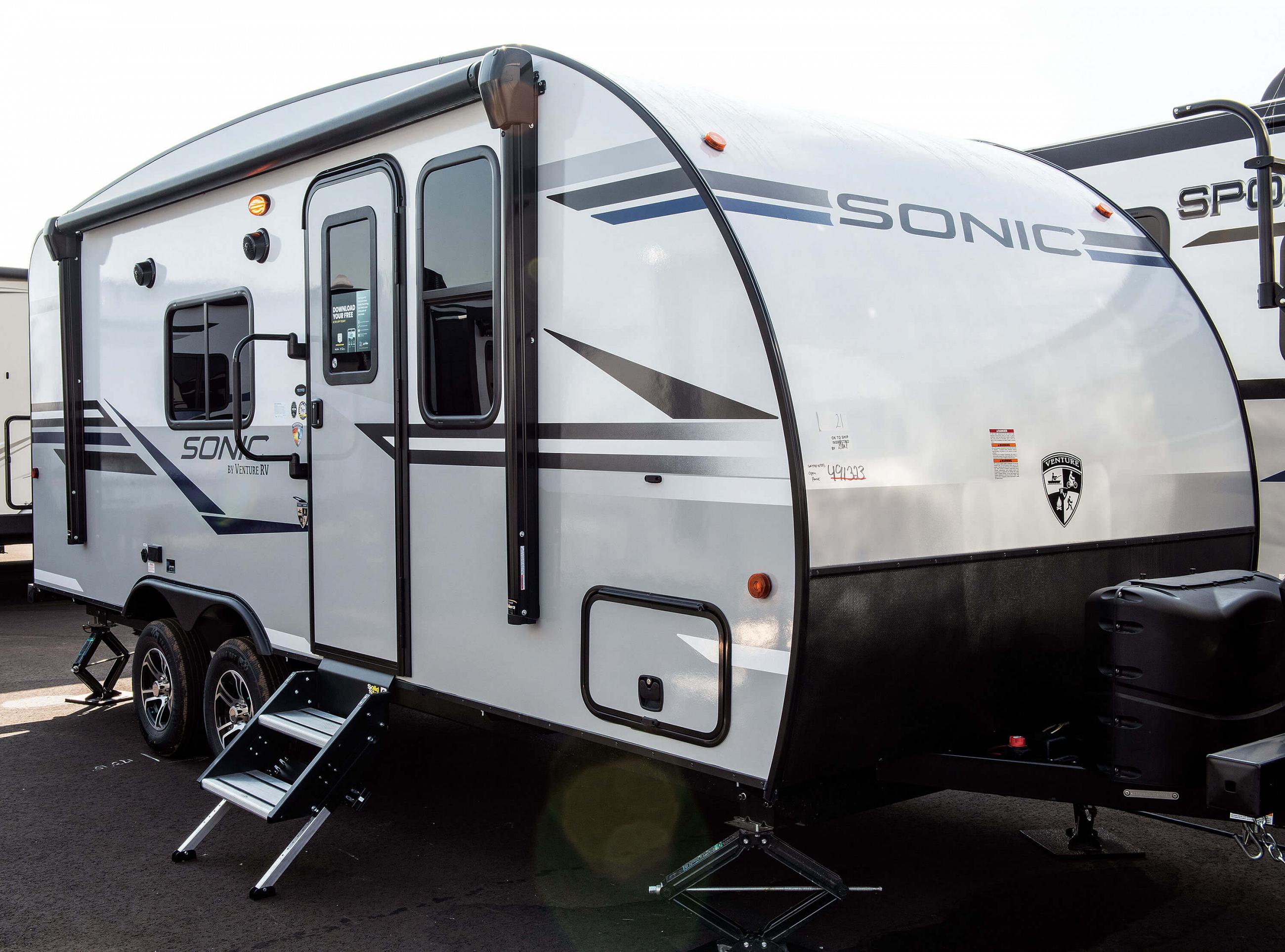
[su_icon_text icon=”icon: star” icon_color=”#00a9e0″]Bottom Line: The Sonic double axle travel trailers weighs under 4,000 pounds, is a compact 19′ size, and has a murphy bed. It’s got terrific interior styling as well. [/su_icon_text]
Venture RVs have only been on the market for about three years, so you’d be forgiven if you had not run across one of their products yet. However, you don’t need to worry about the instability or lack of support seen with some newcomers. Venture is a new brand, but they are owned by Thor, so you can rest assured that they will stand the test of time. Venture RVs has a unique mission statement that is very indicative of the modern RV landscape. They set out to build extremely high-quality campers using durable materials but with compact dimensions. Although their entire line is full of impression options, the SN190VRB stood out.
The SN190VRB is a svelte unit, weighing less than 4,000-pounds. Yet, despite its impressively compact size, the interior of this camper feels significantly more spacious than you would expect from its 19-foot exterior. The layout focuses on open space and versatility. I have seen entirely too many small campers turn into depressing caves when their floorplans try to achieve too many competing goals. With its large rear bath and single-room layout, the Sonic gives you space without compromising functionality.
The key component in this spacious feel is found at the front of the trailer. Rather than having a permanent bed that hinders the space during the day, the Sonic has a murphy bed that folds down over the couch. Thus, at night you have a spacious bedroom, and during the day you have ample room to relax and entertain. It is truly the best of both worlds.
Beyond the creative layout, the quality of the Sonic is extremely impressive. The rounded edges and contrasting wood tones give a very sleek European feel. For years I have been somewhat envious of the high-quality yet compact caravans that travel throughout Europe, especially when compared to the frankly often tacky options we have in the US. Venture RVs seem ready to level that playing field, and I could not be happier for it.
If you’re looking for something even smaller and lighter, we’ve discussed lightweight campers weighing less than 2,000 pounds!
2. Airstream Globetrotter 23FB
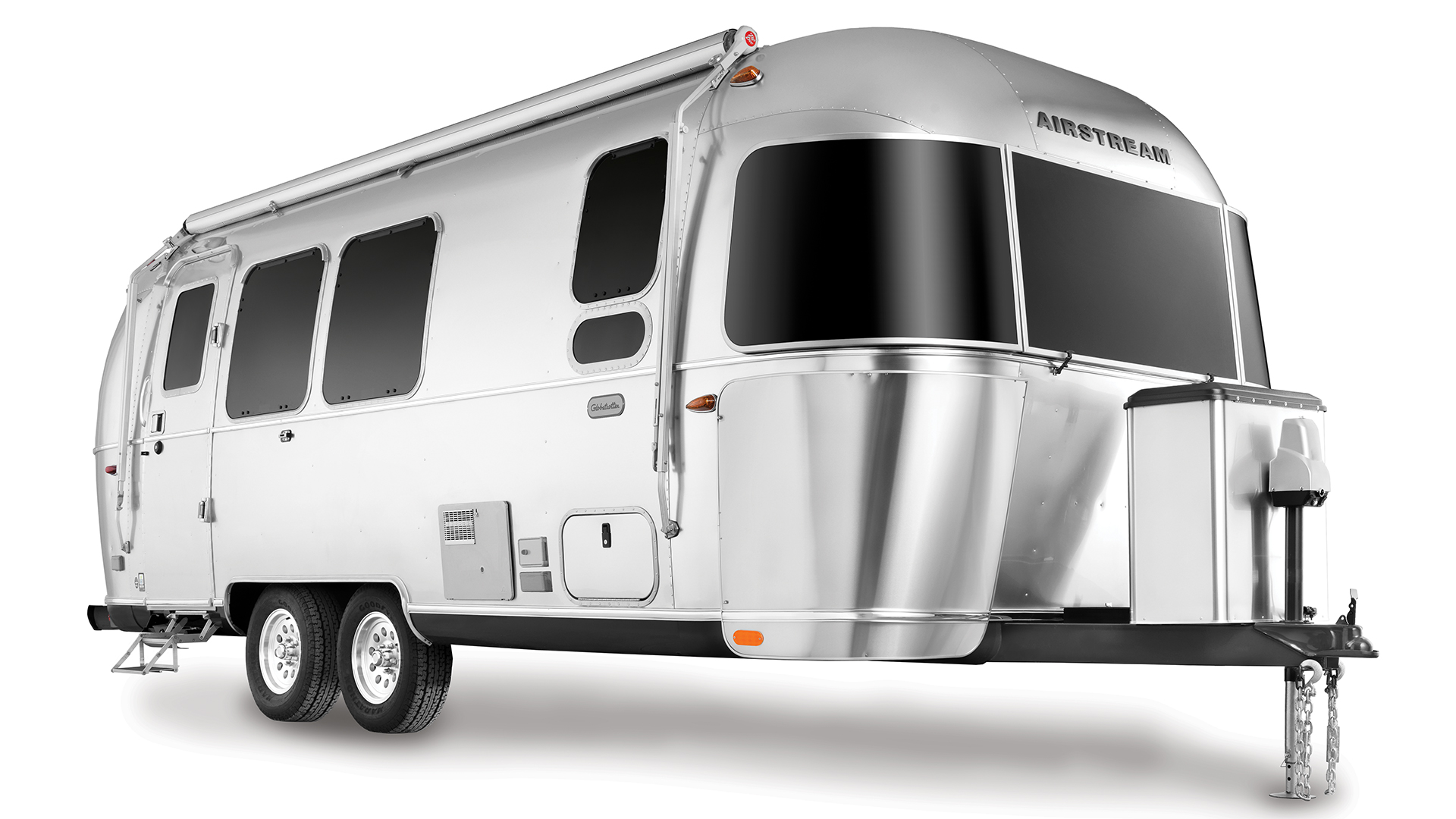
[su_icon_text icon=”icon: star” icon_color=”#00a9e0″]Bottom Line: The Globetrotter double axle trailer is a legendary one. If you can afford the six-figure price tag, and want the best-of-the-best, this is the dual axle camper for you![/su_icon_text]
It’s hard to spend any length of time discussing high-end compact travel trailers without bringing up Airstream. Ever since Wally Byam founded Airstream in 1931, they have created trailers so unique and high-quality that they truly occupy a different category. Airstreams are built more like aircraft than trailers, with their ribbed aluminum construction and polished exteriors lending them an unmistakable look. Yet, it isn’t just the construction. Rather, the quality and attention to detail are superb. One step into an Airstream and you instantly understand. The cabinets feel more substantial. The doors close with surprising bank-vault authority. The feeling is more “yacht” than “camper.”
Despite this reputation for luxury, Airstream has a distinct focus on building smaller trailers. One of their most storied and celebrated models is the minuscule 16-foot Bambi. However, in this article we’re focusing on Airstream’s dual-axle camper that retain compact dimensions. The flagship among this lineup is the Globetrotter 23FB. This front bedroom layout is cozy but never cramped. By having a large U-shaped dinette instead of a sofa and a dinette, the living area has plenty of seating without being cluttered. Upfront, you’ll find a full-size walkaround queen bed, a rare feature in a sub-25-foot trailer.
Without sugarcoating it, this is not a budget-friendly trailer. It’s just over $108,000. While this may seem like an astronomical amount to pay, you would do so with the knowledge that there isn’t a higher quality unit on the road. This is also a prime area where resale value is worth considering. A quick glance at the used market will tell you how well these trailers retain their value. In fact, many seventy-year-old models are still fetching over $100,000. It’s an investment, but it is a solid one.
The Globetrotter 23FB occupies a fascinating space in the market. It’s compact, easy to tow, and very lightweight. Yet, it manages a level of luxury and quality that many 40-foot coaches struggle to achieve. This trailer isn’t for everyone. But for anyone looking for a compact trailer that won’t settle for anything less than the best, this is the one for you.
As a side note, this camper has 70+ years of history. It’s an interesting read if you have time!
3. Genesis RV Vortex 1914V
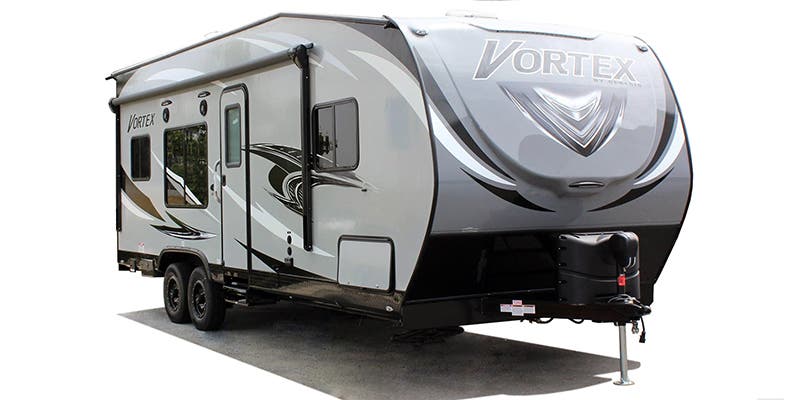
[su_icon_text icon=”icon: star” icon_color=”#00a9e0″]Bottom Line: If you want to safely load up the ATV, dirt bikes, and family for some weekend fun, this dual axle trailer is a hybrid toy hauler… and we love it![/su_icon_text]
After spending some time in the clouds with the Airstream Globetrotter, it is time to return to earth with a more approachable option. Toy haulers.
The appeal of a toy hauler is obvious. You can take your family and your powersports equipment and have a comfortable place to spend time. Furthermore, the appeal of a small trailer has been well discussed. Unfortunately, combining these two concepts is not always a great idea. In recent years, many manufacturers have built toy haulers that amount to little more than taking their low-end single-axle trailers and cutting a door into the back. While this makes them affordable, it also makes them dangerous. The weight distribution of a toy hauler is tricky to manage properly, and combining this with the instability of a single axle design is asking for problems. Worse yet, many of these trailers would technically be overloaded with a single ATV inside. There needed to be a high-quality option for compact toy haulers. Enter the Genesis Vortex 1914V.
At under 20-feet, this is among the most compact toy haulers on the market.
However, because of the overbuilt dual axle frame, it has the strength to haul your toys without putting your family at risk. By using two 4,000-pound axles, this trailer has a payload of almost 3,000-pounds. Thus, you run almost no risk of overloading. The layout is built with capacity in mind as well. Given a clever layout that places the bed and bathroom at the very front, the 1914V has an impressive 14.5-foot garage space. It’s tall, too, being one of the highest profile trailers in this category. The additional height allows for a second motorized bed at the rear, a luxury normally reserved for fifth wheels.
Throughout its design, this trailer is built with adventure and boondocking in mind. It is extremely well insulated, allowing off-grid camping to be done comfortably regardless of the season. And perhaps most impressively, this camper can hold 100 gallons of fresh water. This is easily three times the standard amount. This is a trailer built with a purpose in mind. It isn’t particularly luxurious or elaborately decorated.
If your goal is to have the toughest and most well-equipped compact toy hauler for your next adventure, then this is it.
4. Stealth Nomad 18FK
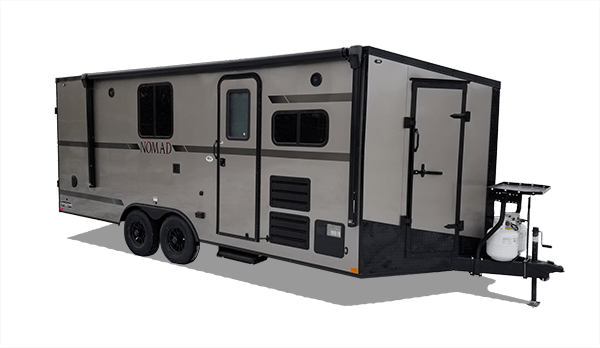
[su_icon_text icon=”icon: star” icon_color=”#00a9e0″]Bottom Line: If you spend more time riding that Yamaha YZ450F and drinking beer (not at the same time of course! ;)), then the Stealth Nomad is an awesome choice for you. It’s a stripped down trailer that crosses a toy hauler with a travel trailer so it’s incredibly affordable, though not the most comfortable. [/su_icon_text]
At first glance, you would be forgiven for thinking the Stealth Nomad 18FK is a fairly similar trailer to the Vortex 1914V. To be fair, their target audience may have a lot of overlap. However, the focus is actually quite different. While the Vortex is a camper first and a toy hauler second, the Nomad reverses that equation.
Stealth is primarily a cargo trailer company, and their bread and butter products are small utility trailers. When they decided to enter the camper market with the Nomad, their approach was predictably unique.
Calling the 18FK a camper is perhaps somewhat misleading. Rather, it is more accurate to think of it as a cargo trailer that happens to have a bathroom and a small kitchen. There aren’t any permanent beds, and such niceties as chairs or a TV are conspicuously absent. Yet, for certain users, this is a fantastic option. If you race motorcycles and are looking for a little more comfort at the track, this is a game-changer. If you use your trailer for trade shows or craft fairs and need to maximize space but still want your own facilities, this is ideal. This trailer gets the job done first and focuses on comfort later.
This focus on capacity is clear when you look at the payload. Because this trailer is so light but built with such heavy-duty components, it has a truly impressive 4,000-pound capacity. Further, because you’re only paying for the bare necessities, the cost is quite approachable too at around $24,000. This is a very specific tool, but it is a great fit for the right job.
If toy haulers are your thing, we have a lot more discussed in our lightweight toy hauler article.
[/su_panel] [su_panel background=”#ffff” shadow=”2px 2px 2px #eeeeee” radius=”4″]Conclusion
I believe it is fair to say that this is the most diverse line-up of trailers we’ve ever featured. This was done for a reason. Compact travel trailers are often relegated to the corner of the RV show and considered basic entry-level models with little variety to offer. But as we’ve seen, the small camper market truly has something for everyone. From the most basic interior possible with the Nomad to the world-class luxury of the Airstream, you will never be left without choices. Small dual-axle trailers are the best of all worlds. Easy to tow, stable, safe, and versatile. It’s simply a matter of finding the right one for you.
[/su_panel]